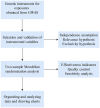Association between leptin and NAFLD: a two-sample Mendelian randomization study
- PMID: 37400922
- PMCID: PMC10316638
- DOI: 10.1186/s40001-023-01147-x
Association between leptin and NAFLD: a two-sample Mendelian randomization study
Abstract
Background: The etiology of nonalcoholic fatty liver disease (NAFLD) involves a complex interaction of genetic and environmental factors. Previous observational studies have revealed that higher leptin levels are related to a lower risk of developing NAFLD, but the causative association remains unknown. We intended to study the causal effect between leptin and NAFLD using the Mendelian randomization (MR) study.
Methods: We performed a two-sample Mendelian randomization (TSMR) analysis using summary GWAS data from leptin (up to 50,321 individuals) and NAFLD (8,434 cases and 770,180 controls) in a European population. Instrumental variables (IVs) that satisfied the three core assumptions of Mendelian randomization were selected. The TSMR analysis was conducted using the inverse variance weighted (IVW) method, MR-Egger regression method, and weighted median (WM) method. To ensure the accuracy and stability of the study results, heterogeneity tests, multiple validity tests, and sensitivity analyses were conducted.
Results: The findings of the TSMR correlation analysis between NAFLD and leptin were as follows: IVW method (odds ratio (OR) 0.6729; 95% confidence interval (95% CI) 0.4907-0.9235; P = 0.0142), WM method (OR 0.6549; 95% CI 0.4373-0.9806; P = 0.0399), and MR-Egger regression method (P = 0.6920). Additionally, the findings of the TSMR correlation analysis between NAFLD and circulating leptin levels adjusted for body mass index (BMI) were as follows: IVW method (OR 0.5876; 95% CI 0.3781-0.9134; P = 0.0181), WM method (OR 0.6074; 95% CI 0.4231-0.8721; P = 0.0069), and MR-Egger regression method (P = 0.8870). It has also been shown that higher levels of leptin are causally linked to a lower risk of developing NAFLD, suggesting that leptin may serve as a protective factor for NAFLD.
Conclusions: Using TSMR analysis and the GWAS database, we investigated the genetic relationship between elevated leptin levels and lowered risk of NAFLD in this study. However, further research is required to understand the underlying mechanisms.
Keywords: Causal effect; Leptin; Nonalcoholic fatty liver disease; Two-sample Mendelian randomization.
© 2023. The Author(s).
Conflict of interest statement
The authors declare no conflict of interest.
Figures




References
MeSH terms
Substances
Grants and funding
LinkOut - more resources
Full Text Sources
Medical

